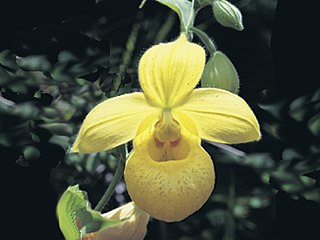
Cypripedioideae is a subfamily of orchids commonly known as lady's slipper orchids, lady slipper orchids or slipper orchids. Cypripedioideae includes the genera Cypripedium, Mexipedium, Paphiopedilum, Phragmipedium and Selenipedium. They are characterised by the slipper-shaped pouches of the flowers – the pouch traps insects so they are forced to climb up past the staminode, behind which they collect or deposit pollinia, thus fertilizing the flower. There are approximately 165 species in the subfamily.

Cypripedium is a genus of 58 species and nothospecies of hardy orchids; it is one of five genera that together compose the subfamily of lady's slipper orchids (Cypripedioideae). They are widespread across much of the Northern Hemisphere, including most of Europe and Africa (Algeria), Russia, China, Central Asia, Canada the United States, Mexico, and Central America. They are most commonly known as slipper orchids, lady's slipper orchids, or ladyslippers; other common names include moccasin flower, camel's foot, squirrel foot, steeple cap, Venus' shoes, and whippoorwill shoe. An abbreviation used in trade journals is "Cyp." The genus name is derived from Ancient Greek Κύπρις (Kúpris), an early reference in Greek myth to Aphrodite, and πέδιλον (pédilon), meaning "sandal".

Cypripedium acaule is a species of flowering plant in the orchid family Orchidaceae native to eastern North America. It is currently the provincial flower of Prince Edward Island, Canada, and the state wildflower of New Hampshire, United States.

Stephanomeria is a genus of North American plants also known as wirelettuce, belonging to the tribe Cichorieae within the family Asteraceae.

Schinus molle is an evergreen tree that grows to 15 meters. It is native to an area from the Peruvian Andes to southern Brazil. The bright pink fruits of Schinus molle are often sold as "pink peppercorns" although S. molle is unrelated to black pepper. The word molle in Schinus molle comes from mulli, the Quechua word for the tree. The tree is host to the pepper-tree moth, Bombycomorpha bifascia.

Atriplex confertifolia, the shadscale or spiny saltbush, is a species of evergreen shrub in the family Amaranthaceae, which is native to the western United States and northern Mexico.

Gutierrezia is a genus of flowering plants in the family Asteraceae, native to western North America and western South America. Plants of this genus are known generally as snakeweeds or matchweeds. Some species have been called greasewood. They are annual or perennial plants or subshrubs with yellow or white flowers.

Chaenactis is a genus of plants in the family Asteraceae which are known generally as pincushions and dustymaidens.

Cypripedium candidum, known as the small white lady's slipper or white lady's slipper, is a rare orchid of the genus Cypripedium. It is native to eastern North America across the northern United States and southern Canada.

Guardiola is a genus of plants in the family Asteraceae, native to Mexico and the southwestern United States. Members of the genus are subshrubs with simple, opposite leaves and terminal inflorescences.

The Comisión Nacional para el Conocimiento y Uso de la Biodiversidad is a permanent inter-ministerial commission of the Federal Mexican government, created in 1992. It has the primary purpose of coordinating, supporting and executing activities and projects designed to foment understanding of biodiversity within Mexico and the surrounding region. As a governmental agency, CONABIO produces and collates biodiversity data and assessments across Mexico's varied ecosystems. It also either administers or guides a range of biological conservation and sustainability projects with the intention of securing benefits to Mexican society as a whole.

Cypripedium irapeanum, known as Irapeao's cypripedium or pelican orchid, is a species of orchid found in Mexico and Central America in section irapeana. It has a widespread distribution from the central Mexico states of Sinaloa and Durango south to Guatemala and Honduras. They are found in mixed pine and oak forests on well-drained limestone slopes and in areas with volcanic and clay soil which are rich in metals. They can be found in some areas in groups of hundreds. They bloom from early June to late July.

Cypripedium reginae, known as the showy lady's slipper, pink-and-white lady's-slipper, or the queen's lady's-slipper, is a rare lady's-slipper orchid native to northern North America. Although never common, this plant has vanished from much of its historical range due to habitat loss. It is the state flower of Minnesota.
Greenmaniella is a genus of flowering plants in the daisy family.
Chromolepis is a genus of flowering plants in the family Asteraceae.

Calibanus was a genus of two species of flowering plants, both evergreen succulents from dry areas of northeastern Mexico.The genus was subsumed in the genus Beaucarnea in the year 2014. The APG III classification system places Beaucarnea in the family Asparagaceae, subfamily Nolinoideae The now-defunct Calibanus was formerly included in the Agavaceae but was separated from them, for it is polycarpic and dioecious. Its name refers to the monster Caliban, an antagonist in Shakespeare's The Tempest.

Rhynchostele is a genus of flowering plants from the orchid family, Orchidaceae, native to Mexico, Central America and Venezuela. The genus name is abbreviated as Rst. in the horticultural trade.

Cypripedium calceolus is a lady's-slipper orchid, and the type species of the genus Cypripedium. It is native to Europe and Asia.

Gibasis oaxacana is species of flowering plants within the Gibasis genus, first described in 1972. It is endemic to the State of Oaxaca in southern Mexico.

Brachystele guayanensis is a species of orchid. It is native to southern Mexico, Central America, Trinidad & Tobago, and northern South America.

















